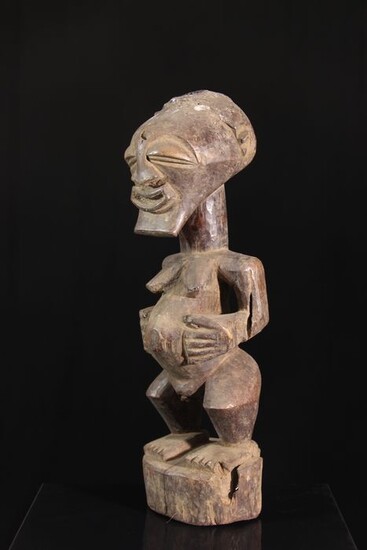Ancestor statue (1) - Wood - Songye - DR Congo
Origin: DRC Tribe name: Songye Material (s) : Wood Dimensions (in cm) : 40 x 10 x 13 Weight (in grams) : 1500 Shipping method: Postal delivery The Songye ’are widely known for their statues, large (about 70 to 90 centimeters high, sometimes less; collective) or small (usually less than 35 centimeters, in some cases less than 10; individual) . In fact, most of the statues that iconography allows us to know today are of Kalebwe origin (ekie and ilande also, sanga, mona and tempa too, which are neighboring groups, all of them occupy the western part of the region. Songye34 and the sculptors photographed by Hersak are Kalebwe for two of them, the third being ciofwe - a neighboring chiefdom which, at the time of Lumpungu's father, and following a dispute, became independent from the Kalebwe chiefdom) while the statuettes come, in the vast majority of cases, from the populations east of the Lomami and from the Kalebwe groups found on the eastern bank of this river. A few very peculiar statues operated in a specific register in a very localized area and a specific time in the east of the region known today as Songye. Lacks are visible on the statue. The horn is missing and traces of ritual residue are visible.
[ translate ]View it on
Sale price
Estimate
Time, Location
Auction House
Origin: DRC Tribe name: Songye Material (s) : Wood Dimensions (in cm) : 40 x 10 x 13 Weight (in grams) : 1500 Shipping method: Postal delivery The Songye ’are widely known for their statues, large (about 70 to 90 centimeters high, sometimes less; collective) or small (usually less than 35 centimeters, in some cases less than 10; individual) . In fact, most of the statues that iconography allows us to know today are of Kalebwe origin (ekie and ilande also, sanga, mona and tempa too, which are neighboring groups, all of them occupy the western part of the region. Songye34 and the sculptors photographed by Hersak are Kalebwe for two of them, the third being ciofwe - a neighboring chiefdom which, at the time of Lumpungu's father, and following a dispute, became independent from the Kalebwe chiefdom) while the statuettes come, in the vast majority of cases, from the populations east of the Lomami and from the Kalebwe groups found on the eastern bank of this river. A few very peculiar statues operated in a specific register in a very localized area and a specific time in the east of the region known today as Songye. Lacks are visible on the statue. The horn is missing and traces of ritual residue are visible.
[ translate ]



